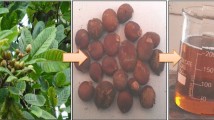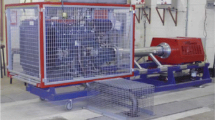Abstract
The purpose of this study is to experimentally investigate the effect of unsaturation of the biodiesels obtained from grapeseed oil, wheat germ oil and coconut oil (reference fuel) for compression ignition (CI) engine application. Fatty acid profile analysis and physio-chemical properties were determined by standard test procedures. Engine testing was carried out in a 5.2-kW single-cylinder CI engine and the combustion, performance and emission characteristics were analysed. The effect of fuel property variation and the combustion reaction kinetics due to unsaturation difference have been discussed. The maximum brake thermal efficiency at full load for diesel was found to be 32.3% followed by 31.3%, 30.2% and 27.4 %, respectively, for coconut biodiesel (CBD), grapeseed biodiesel (GSBD) and wheat germ biodiesel (WGBD). Maximum heat release rate as observed for diesel, CBD, GSBD and WGBD are 63.2 J/°CA 60.7 J/°CA and 59 J/°CA and 43.4 J/°CA respectively. The brake-specific NO emission at full load is higher for CBD followed by GSBD, WGBD and diesel having values of 9.23 g/kWh, 8.91 g/kWh, 8.21 g/kWh and 7.6 g/kWh respectively. Conversely, the smoke emission is lower for CBD compared to the other tested fuels.













Similar content being viewed by others
References
Aggarwal SK (2018) Effect of fuel unsaturation on emissions in flames and diesel engines. Green Energy and Technology:51–76. https://doi.org/10.1007/978-981-10-7473-8_3
Benjumea P, Agudelo JR, Agudelo AF (2011) Effect of the degree of unsaturation of biodiesel fuels on engine performance, combustion characteristics, and emissions. Energy Fuel 25(1):77–85. https://doi.org/10.1021/ef101096x
Bowman CT (1975) Kinetics of pollutant formation and destruction in combustion. Prog Energy Combust Sci 1(1):33–45. https://doi.org/10.1016/0360-1285(75)90005-2
Canakci M (2007) The potential of restaurant waste lipids as biodiesel feedstocks. Bioresour Technol 98(1):183–190
Cheng, W. L., Lee, C. F., & Ruan, D. F. (2008). Comparisons of combustion characteristics of biodiesels in a high speed direct injection diesel engine (No. 2008-01-1638). SAE Technical Paper.
Coleman HW, Steele WG (2009) Experimentation, validation, and uncertainty analysis for engineers. John Wiley & Sons
Das DD, McEnally CS, Pfefferle LD (2015) Sooting tendencies of unsaturated esters in non-premixed flames. Com ustion and Flame 162(4):1489–1497. https://doi.org/10.1016/j.combustflame.2014.11.012
Dayma G, Halter F, Foucher F, Mounaim-Rousselle C, Dagaut P (2012) Laminar burning velocities of C4–C7 ethyl esters in a spherical combustion chamber: experimental and detailed kinetic modeling. Energy Fuel 26(11):6669–6677. https://doi.org/10.1021/ef301254q
Demirbas A (2009) Progress and recent trends in biodiesel fuels. Energy Convers Manag 50(1):14–34
Demirbas A (2011) Competitive liquid biofuels from biomass. Appl Energy 88(1):17–28
Devesa-Rey R, Vecino X, Varela-Alende JL, Barral MT, Cruz JM, Moldes AB (2011) Valorization of winery waste vs. the costs of not recycling. Waste Manag 31(11):2327–2335
Fernández CM, Ramos MJ, Pérez Á, Rodríguez JF (2010) Production of biodiesel from winery waste: extraction, refining and transesterification of grape seed oil. Bioresour Technol 101(18):7019–7024
Fisher EM, Pitz WJ, Curran HJ, Westbrook CK (2000) Detailed chemical kinetic mechanisms for combustion of oxygenated fuels. Proc Combust Inst 28(2):1579–1586. https://doi.org/10.1016/s0082-0784(00)80555-x
Görner C, Redai V, Bracharz F, Schrepfer P, Garbe D, Brück T (2016) Genetic engineering and production of modified fatty acids by the non-conventional oleaginous yeast Trichosporon oleaginosus ATCC 20509. Green Chem 18(7):2037–2046. https://doi.org/10.1039/c5gc01767j
Graboski MS, McCormick RL (1998) Combustion of fat and vegetable oil derived fuels in diesel engines. Prog Energy Combust Sci 24(2):125–164
Grana R, Frassoldati A, Saggese C, Faravelli T, Ranzi E (2012) A wide range kinetic modeling study of pyrolysis and oxidation of methyl butanoate and methyl decanoate – note II: lumped kinetic model of decomposition and combustion of methyl esters up to methyl decanoate. Combustion and Flame 159(7):2280–2294. https://doi.org/10.1016/j.combustflame.2012.02.027
Lapuerta M, Armas O, Rodriguez-Fernandez J (2008) Effect of the degree of unsaturation of biodiesel fuels on NOx and particulate emissions. SAE International Journal of Fuels and Lubricants 1(1):1150–1158. https://doi.org/10.4271/2008-01-1676
Lin CSK, Koutinas AA, Stamatelatou K, Mubofu EB, Matharu AS, Kopsahelis N et al (2014) Current and future trends in food waste valorization for the production of chemicals, materials and fuels: a global perspective. Biofuels Bioprod Biorefin 8(5):686–715
Mahmoud AA, Mohdaly AAA, Elneairy NAA (2015) Wheat germ: an overview on nutritional value, antioxidant potential and antibacterial characteristics. Food Nutr Sci 06(02):265–277. https://doi.org/10.4236/fns.2015.62027
Masimalai SK, Venkatesan K (2014) Experimental investigations on a diesel engine using coconut shell pyro oil (CSPO)-diesel blends as fuel (No. 2014-01-1377). SAE Technical Paper.
Meng X, Chen G, Wang Y (2008) Biodiesel production from waste cooking oil via alkali catalyst and its engine test. Fuel Process Technol 89(9):851–857
Mirabella N, Castellani V, Sala S (2014) Current options for the valorization of food manufacturing waste: a review. J Clean Prod 65:28–41
Mofijur M, Atabani AE, Masjuki HA, Kalam MA, Masum BM (2013) A study on the effects of promising edible and non-edible biodiesel feedstocks on engine performance and emissions production: a comparative evaluation. Renew Sust Energ Rev 23:391–404
Mrad N, Varuvel EG, Tazerout M, Aloui F (2012) Effects of biofuel from fish oil industrial residue–Diesel blends in diesel engine. Energy 44(1):955–963
Puhan S, Saravanan N, Nagarajan G, Vedaraman N (2010) Effect of biodiesel unsaturated fatty acid on combustion characteristics of a DI compression ignition engine. Biomass Bioenergy 34(8):1079–1088
Sahoo PK, Das LM (2009) Combustion analysis of Jatropha, Karanja and Polanga based biodiesel as fuel in a diesel engine. Fuel 88(6):994–999
Schönborn A, Ladommatos N, Williams J, Allan R, Rogerson J (2009) The influence of molecular structure of fatty acid monoalkyl esters on diesel combustion. Combustion and Flame 156(7):1396–1412. https://doi.org/10.1016/j.combustflame.2009.03.011
Selvam DJP, Vadivel K (2012) Performance and emission analysis of DI diesel engine fuelled with methyl esters of beef tallow and diesel blends. Procedia Engineering 38:342–358
Stansell GR, Gray VM, Sym SD (2011) Microalgal fatty acid composition: implications for biodiesel quality. J Appl Phycol 24(4):791–801. https://doi.org/10.1007/s10811-011-9696-x
Tat ME, Wang PS, Van Gerpen JH, Clemente TE (2007) Exhaust emissions from an engine fueled with biodiesel from high-oleic soybeans. J Am Oil Chem Soc 84(9):865–869. https://doi.org/10.1007/s11746-007-1109-6
Vallinayagam R, Vedharaj S, Yang WM, Lee PS, Chua KJE, Chou SK (2013) Combustion performance and emission characteristics study of pine oil in a diesel engine. Energy 57:344–351
Westbrook CK, Dryer FL (1984) Chemical kinetic modeling of hydrocarbon combustion. Prog Energy Combust Sci 10(1):1–57. https://doi.org/10.1016/0360-1285(84)90118-7
Westbrook CK, Pitz WJ, Curran HJ (2006) Chemical kinetic modeling study of the effects of oxygenated hydrocarbons on soot emissions from diesel engines. J Phys Chem A 110(21):6912–6922
Yang B, Westbrook CK, Cool TA, Hansen N, Kohse-Höinghaus K (2011) The effect of carbon–carbon double bonds on the combustion chemistry of small fatty acid esters. Z Phys Chem 225(11-12):1293–1314. https://doi.org/10.1524/zpch.2011.0167
Yusuf NNAN, Kamarudin SK, Yaakub Z (2011) Overview on the current trends in biodiesel production. Energy Convers Manag 52(7):2741–2751
Zacharof MP (2017) Grape winery waste as feedstock for bioconversions: applying the biorefinery concept. Waste and biomass valorization 8(4):1011–1025
Zádor J, Taatjes CA, Fernandes RX (2011) Kinetics of elementary reactions in low temperature autoignition chemistry. Prog Energy Combust Sci 37(4):371–421. https://doi.org/10.1016/j.pecs.2010.06.006
Author information
Authors and Affiliations
Corresponding author
Additional information
Responsible editor: Philippe Garrigues
Highlights
• The winery industry generates both solid and liquid organic and inorganic waste in large quantities.
• Solid wastes generated are often hard to biodegrade or are subject to complicated procedures or simply discarded into the environment.
• Wheat germ which is basically a by-product of wheat milling industry comes under the category of xylose-rich biomass waste streams.
• Grapeseed from the biomass waste of the winery industry, and wheat germ, a by-product of the wheat milling industry, is used as an energy source for internal combustion engine application.
• Unsaturation effects of grapeseed biodiesel and wheat germ biodiesel on combustion, emission and performance characteristics in a CI engine are compared with less unsaturated coconut biodiesel.
• Property effects due to unsaturation variation and reaction kinetics involved have been discussed.
Rights and permissions
About this article
Cite this article
Chelladorai, P., Varuvel, E.G., Martin, L.J. et al. The potential impact of unsaturation degree of the biodiesels obtained from beverage and food processing biomass streams on the performance, combustion and emission characteristics in a single-cylinder CI engine. Environ Sci Pollut Res 26, 5008–5019 (2019). https://doi.org/10.1007/s11356-018-3793-1
Received:
Accepted:
Published:
Issue Date:
DOI: https://doi.org/10.1007/s11356-018-3793-1




